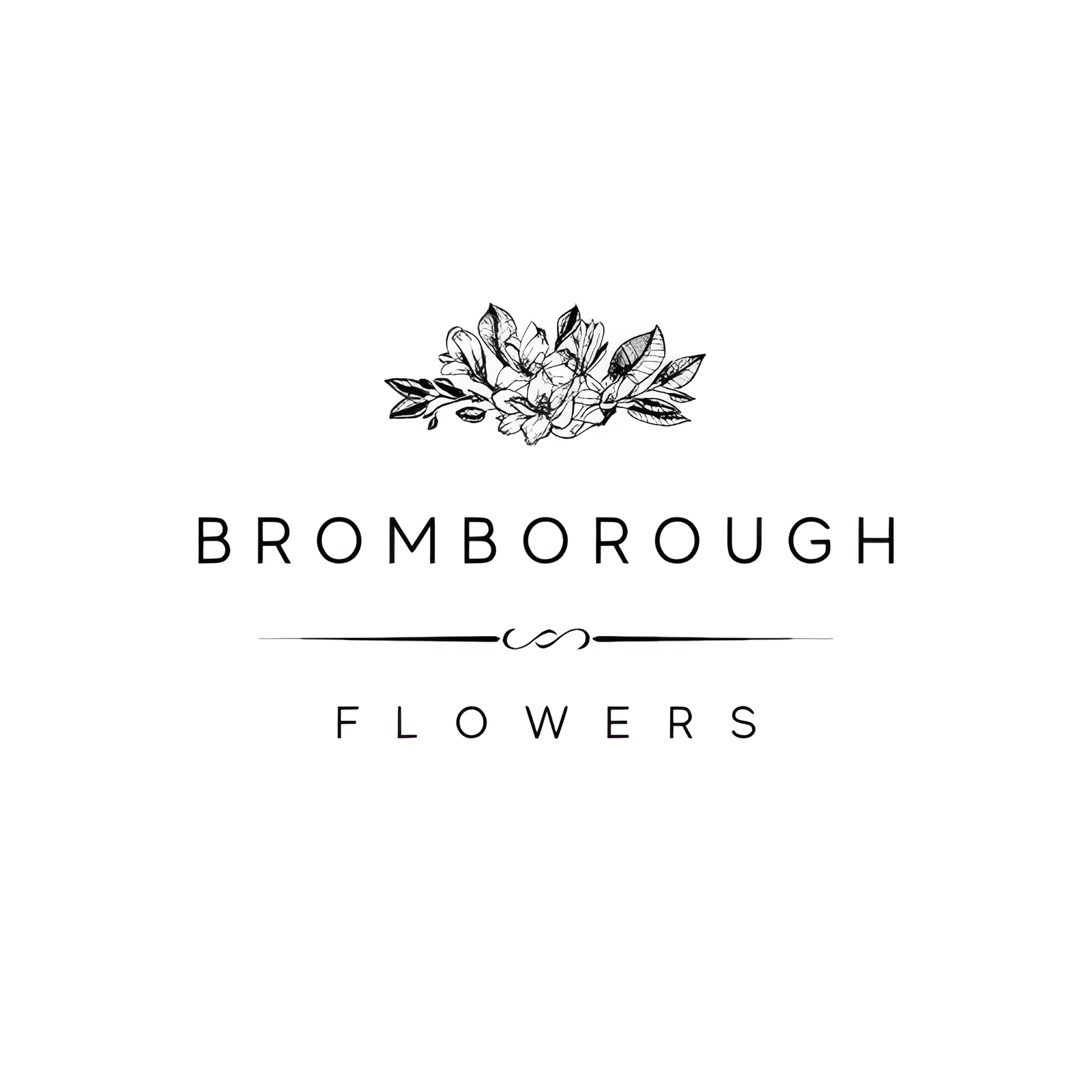Azaleas stand out as an ideal choice for wedding decor due to their striking blooms and rich symbolism. Their petite evergreen shrubs offer lush double flowers in a diverse palette, ranging from serene whites to vibrant reds, catering to various wedding themes. Thriving in cool, moist climates, azaleas provide an extended blooming period from spring through fall. Whether incorporated into bouquets, centerpieces, or venue decorations, these flowers infuse elegance and sentiment into the celebration. To fully appreciate the unique qualities and potential uses of azaleas in wedding settings, it is essential to explore their botanical characteristics and cultural significance.
Flower Overview
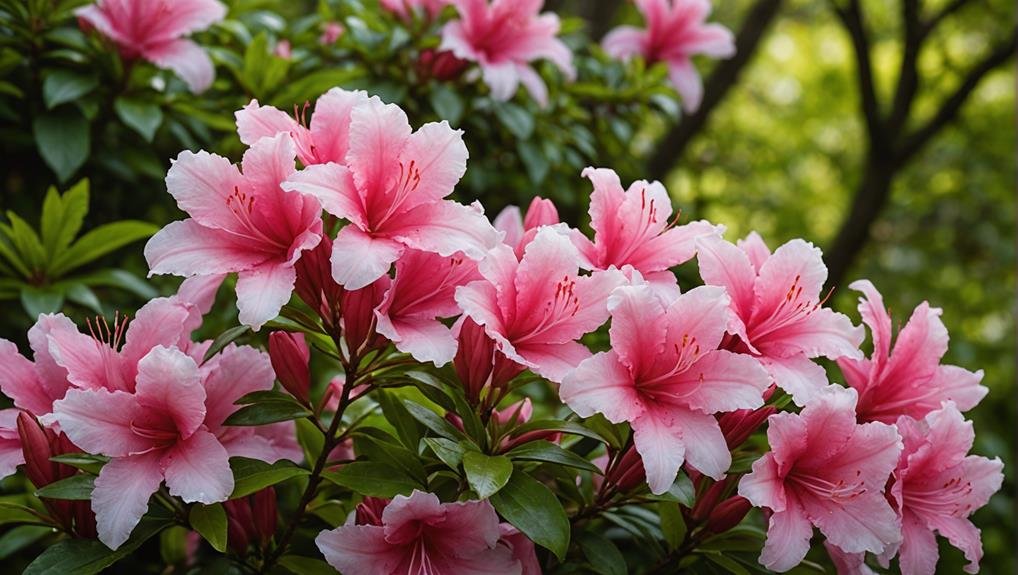
Azaleas, frequently admired for their vibrant blooms and symbolic meanings of femininity and passion, are a favorite choice for wedding floral arrangements. These flowers offer an extended blooming period from spring through fall, making them a prime choice for many wedding dates. Their availability throughout the wedding season guarantees that brides and grooms can enjoy their beauty regardless of the time of year.
Encore Azaleas, in particular, are highly regarded for wedding purposes due to their continuous blooms and diverse color palette. This variety's adaptability allows them to enhance various aspects of wedding decor, including bridal bouquets, corsages, boutonnieres, and even larger decorations such as altars, chairs, and arbors. Their vibrant hues can seamlessly blend with or accentuate any wedding color scheme, providing a cohesive and visually appealing aesthetic.
The versatility of azaleas as wedding flowers cannot be overstated. Their ability to complement a wide range of wedding themes and settings makes them a dependable and elegant choice for couples. Whether featured prominently in bouquets or as part of intricate decorations, azaleas bring a unique touch of beauty and symbolism to any wedding celebration.
Physical Description
Distinguished for their petite evergreen nature, these shrubs are particularly recognized for producing abundant double white flowers during the spring season. Azaleas are an excellent choice for mass planting or inclusion in container arrangements on patios, providing a picturesque and elegant addition to any outdoor space. The compact nature of the Brides Bouquet Azaleas makes sure they are manageable, with a maximum growth width of approximately 70cm, making them suitable for various garden designs and layouts.
The physical structure of the azalea is characterized by its dense, bushy foliage, which remains lush and green throughout the year. This consistent greenery provides a vibrant backdrop for the striking white flowers that emerge each spring, adding a fresh and clean aesthetic to any environment. The double blooms are notably full and rich in texture, enhancing their visual appeal and making them a favored option for decorative purposes, including wedding bouquets and floral arrangements.
To maintain the health and beauty of these azaleas, it is important to provide adequate watering and perform trimming after the flowering period. They thrive in cool, moist conditions free from lime, and are well-suited to clay soil, ensuring they remain a resilient and lasting choice for gardeners and floral enthusiasts alike.
Available Colour Varieties
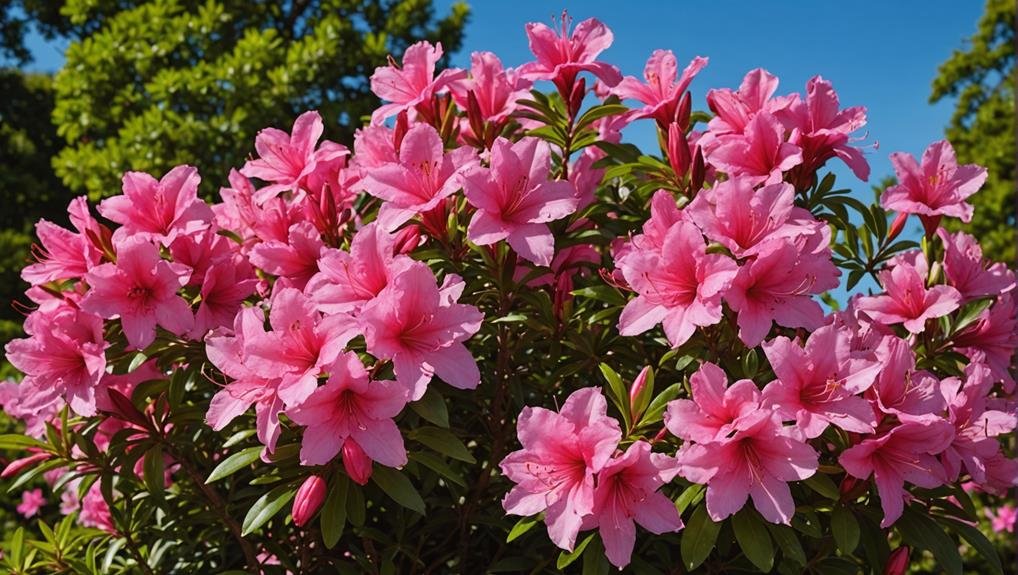
In the world of wedding decor, azaleas offer a versatile palette with color varieties ranging from pristine whites to vibrant reds. This diversity makes azaleas an ideal choice for various wedding themes and styles.
White azaleas, such as the Autumn Angel and Autumn Ivory, provide a classic and elegant choice, perfect for traditional ceremonies. These varieties lend a timeless beauty and sophistication to any floral arrangement.
For a romantic and feminine touch, pink azaleas like Autumn Princess and Autumn Coral are excellent options. Their soft hues can enhance the delicate and enchanting atmosphere of a wedding.
Meanwhile, purple azaleas such as Autumn Lilac bring a regal and luxurious feel, making them suitable for more opulent and grand wedding settings.
Red azaleas, including Autumn Bravo and Autumn Embers, offer a bold and passionate pop of color, ideal for couples looking to make a striking statement with their floral decorations.
Additionally, bi-colored varieties like Autumn Chiffon and Autumn Starlite provide unique and eye-catching options, combining multiple shades in a single bloom.
Latin Name and Taxonomy
The Azalea, known scientifically as Rhododendron, belongs to the Ericaceae family, encompassing a vast array of over 10,000 varieties and hybrids. This Latin name, Rhododendron, is derived from the Greek words 'rhodos' meaning rose and 'dendron' meaning tree, highlighting the plant's beautiful flowering nature. Azaleas are classified as flowering shrubs and are widely admired for their vibrant and diverse blooms.
The taxonomy of Azaleas is intricate, with these plants being divided into several subgenera and sections based on their unique characteristics and traits. This classification system aids botanists and horticulturists in the proper identification, cultivation, and care of these ornamental plants. Understanding the taxonomy is vital for anyone looking to incorporate Azaleas into their wedding arrangements, as it guarantees the selection of the most suitable varieties for different climates and soil conditions.
The Azalea's extensive variety means there is a type for almost every aesthetic preference and environmental requirement. By recognizing the Latin name and the detailed taxonomy of Azaleas, florists and gardeners can make informed decisions, making sure that these stunning shrubs thrive and contribute to the beauty of their intended displays.
Geographical Origins

Understanding the rich taxonomy of Azaleas is complemented by exploring their geographical origins, which trace back to Asia before their introduction to the United States in the 18th century. Azaleas, part of the Rhododendron genus, are native to temperate regions across Asia, particularly thriving in countries like Japan, China, and Korea. These regions provided the ideal conditions for the development of their stunning blooms and diverse varieties.
After their introduction to the United States, Azaleas found a new home in the Southeastern U.S., a region whose temperate climate mirrors that of their native habitats. This area has become a prime region for their growth, offering the necessary environment for Azaleas to flourish. The Southeastern U.S. now boasts numerous gardens and landscapes adorned with over 10,000 varieties of these flowering shrubs.
Azaleas have a significant presence in American horticulture and are prized for their versatility and vibrant display of colors. Their ability to adapt to different climates and settings has made them a beloved choice for weddings, symbolizing femininity, passion, and beauty in bridal arrangements.
Understanding their geographical origins enhances our appreciation of the Azalea's journey from Asian landscapes to becoming a staple in Western floral design.
Season Availability
Azaleas, owing to their reblooming nature, are a versatile floral choice for weddings all year round. This makes them an excellent choice for couples seeking to incorporate beautiful blooms regardless of their wedding date. Encore Azaleas, specifically, offer an extended season availability, blooming from spring through fall. This prolonged bloom period guarantees that these flowers are accessible for a wide range of wedding styles and themes.
The array of colors present in Encore Azaleas enhances their versatility for various wedding palettes. From striking reds to delicate pinks and whites, these blooms can complement any decor. Their usefulness goes beyond bouquets, as azaleas can be seamlessly integrated into corsages, boutonnieres, and venue decorations, like altars and chair embellishments.
Moreover, potted Encore Azaleas make for considerate and enduring favors or gifts for wedding guests, adding a memorable and lasting touch to the event.
| Season | Availability |
|---|---|
| Spring | High |
| Summer | High |
| Fall | High |
| Winter | Moderate |
| Year-Round | Yes |
The consistent presence of azaleas throughout the year guarantees that couples have a dependable and lovely floral option for their special day.
Growing Conditions
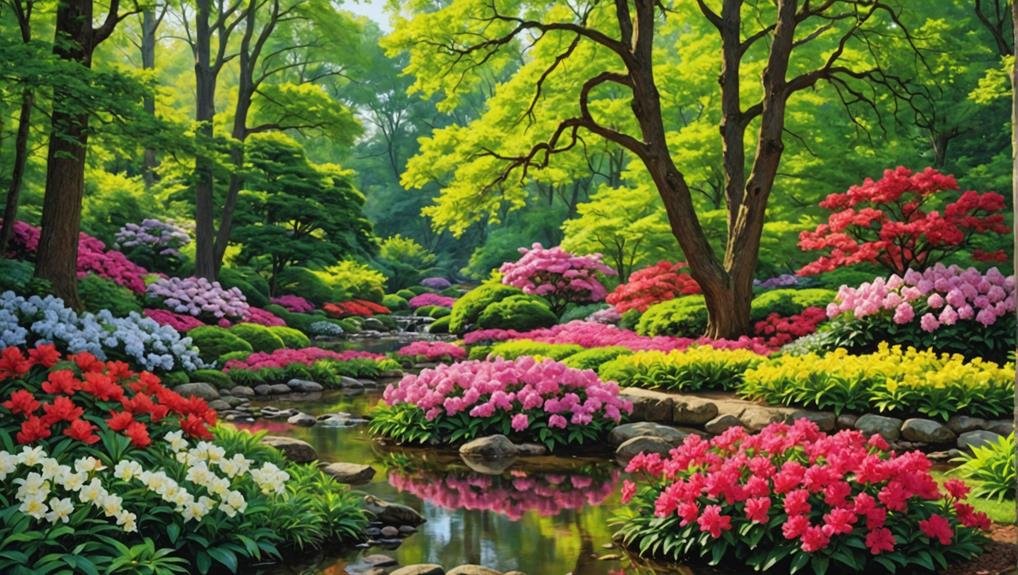
Thriving in well-drained, acidic soil, azaleas demand specific growing conditions to flourish. The best soil pH for azaleas ranges between 4.5 and 6.0. These plants prefer partial shade with morning sun exposure, which helps to maintain their vibrant blooms while shielding them from the intense afternoon sun. Regular watering is essential, especially during dry periods, to keep the soil consistently moist but not waterlogged.
For those considering planting in containers, azaleas are an excellent choice due to their manageable size and adaptability. Make sure that the container has adequate drainage holes and use a potting mix designed for acid-loving plants. Here are three key steps to successful container planting:
- Choose the Right Container: Select a container that is spacious enough to accommodate the root system and has sufficient drainage.
- Use Appropriate Soil: Fill the container with well-drained, acidic potting mix to provide the ideal growing environment.
- Regular Maintenance: Water consistently and mulch around the base to retain moisture and regulate soil temperature.
Pruning azaleas after flowering helps maintain their shape and promotes new growth. Mulching around the base of the plant further assists in moisture retention and soil temperature regulation, ensuring the plant's peak health and beauty.
Cultural Significance
Celebrated for their symbolism of femininity and passion, azaleas hold a cherished place in various cultural and ceremonial contexts, including weddings. The azalea flower is revered across different societies for its vibrant beauty and the profound meanings it embodies. This flower has gained considerable attention in significant events, such as the royal wedding of Kate Middleton, highlighting its cultural significance and timeless appeal.
The azalea flower blooms from spring through fall, providing a long-lasting source of elegance and color for wedding ceremonies. This extended blooming period allows for greater flexibility in planning and incorporating azaleas into diverse wedding themes and color palettes.
Below is a table summarizing the cultural importance of the azalea flower:
| Aspect | Detail | Example |
|---|---|---|
| Symbolism | Femininity and passion | Popular in bridal bouquets |
| Cultural Significance | Featured in high-profile weddings | Kate Middleton's royal wedding |
| Blooming Period | Spring through fall | Suitable for various wedding seasons |
| Versatility | Usable in bouquets, hairpieces, and cake decorations | Adds elegance and vibrancy |
The versatility of the azalea flower, with its wide range of colors and re-blooming capabilities, makes it an ideal choice for creating stunning wedding decor arrangements. The use of Encore Azaleas, in particular, guarantees a continuous display of beauty and charm throughout the celebration.
Typical Use in Weddings
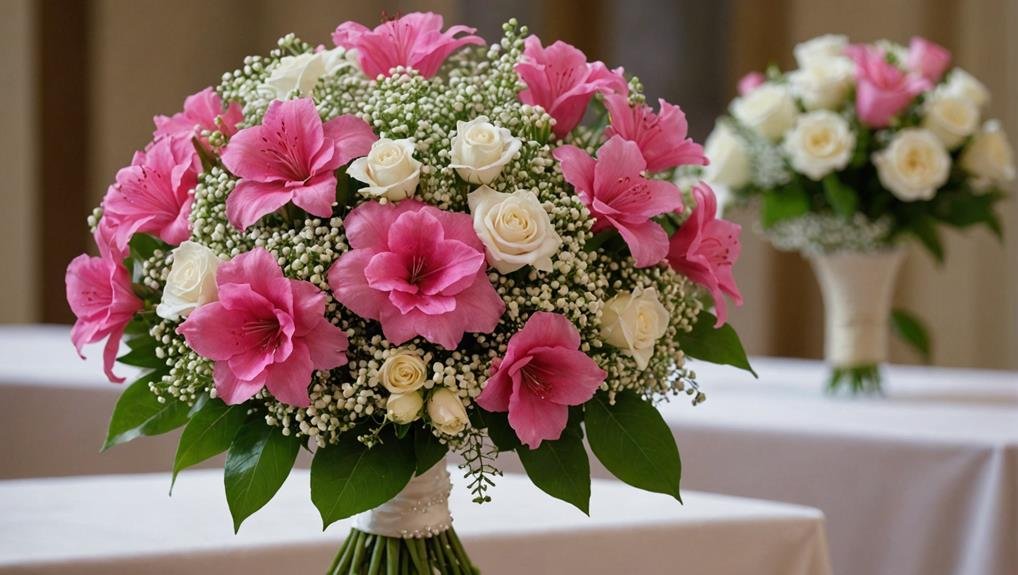
In weddings, reblooming azaleas are frequently utilized for their ability to provide continuous and vibrant floral displays throughout the event. Their consistent blooming makes them ideal for various wedding settings, from the ceremony to the reception.
Azaleas, particularly the Encore variety, are favored for their versatility and the range of colors they offer, such as white, pink, purple, red, and bi-colored options. These characteristics allow them to complement any wedding color scheme seamlessly.
The use of azaleas in weddings can be categorized into three primary applications:
- Bridal Bouquets: Azaleas symbolize femininity and passion, making them an excellent choice for bridal bouquets, adding a touch of elegance and emotion.
- Cake Decorations: Their vibrant blooms can be used to adorn wedding cakes, enhancing their visual appeal and aligning with the overall floral theme.
- Ceremonial and Reception Decor: As potted plants, azaleas can be strategically placed around the venue, creating lush, inviting spaces that captivate guests.
Alternative Flower Types
When considering alternative flower types for wedding arrangements, roses, hydrangeas, lilies, and peonies each offer unique attributes that can enhance the overall aesthetic and emotional resonance of the event. Roses, known for their timeless elegance, symbolize love and romance, making them a quintessential choice for bridal bouquets and centerpieces. Hydrangeas, with their lush, full blooms, represent gratitude and abundance, offering a meaningful and visually striking option for wedding decor.
Lilies, often associated with purity and devotion, are a popular choice for wedding ceremonies, adding a touch of sophistication and grace to any setting. Peonies, renowned for their luxurious, voluminous petals, symbolize prosperity and good fortune, infusing wedding floral designs with an element of charm and elegance.
Below is a comparative table highlighting the key attributes of these alternative flowers:
| Flower Type | Symbolism | Ideal Usage |
|---|---|---|
| Roses | Love and Romance | Bridal Bouquets, Centerpieces |
| Hydrangeas | Gratitude and Abundance | Ceremony Decor, Reception Arrangements |
| Lilies | Purity and Devotion | Altar Arrangements, Bridal Bouquets |
| Peonies | Prosperity and Fortune | Bouquets, Table Centerpieces |
These alternative flowers provide a range of options to suit different wedding themes and styles, ensuring that each couple can find the perfect floral accent for their special day.
